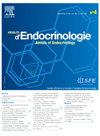Ferroptose
IF 2.9
3区 医学
Q3 ENDOCRINOLOGY & METABOLISM
引用次数: 0
Abstract
Cells can adopt distinct states independently of genetic alterations, a biological process commonly referred to as “cell plasticity”. Acquisition of distinct cell states is characterized by the upregulation of the plasma membrane glycoprotein CD44 in development, immunity and cancer. Although often described as a cell-surface marker, the biological function of CD44 has remained elusive. We discovered that CD44 mediates the uptake of specific metals, including copper and iron in various tissue types using hyaluronans as carriers. This glycan-mediated metal endocytosis mechanism enables immune cell activation and acquisition of a therapy-resistant state of cancer cells. Increase of copper(II) in mitochondria sustains NAD(H) redox cycling, enabling the production of metabolites that co-regulate the epigenetic programming of cell identity. In contrast, increase of iron in the nucleus promotes the activity of specific iron- and ketoglutarate-dependent demethylases, activating specific transcriptional programs. We developed new classes of small molecules that selectively interfere with these metal-catalyzed chemical processes in cells. Inactivating mitochondrial copper(II) prevents acute inflammation in vivo demonstrating that control of cell plasticity confers therapeutic benefits. Activation of lysosomal iron induces ferroptosis in therapy-resistant cancer cells, reducing cancer metastasis. These findings illuminate a universal metal uptake mechanism and the critical role of metals as master regulators of cell plasticity, paving the way towards the development of next generation therapeutics.
铁硫糖
细胞可以独立于基因改变而采用不同的状态,这一生物学过程通常被称为 "细胞可塑性"。在发育、免疫和癌症过程中,细胞获得不同状态的特征是质膜糖蛋白 CD44 的上调。虽然 CD44 常被描述为细胞表面标志物,但其生物学功能却一直难以捉摸。我们发现,CD44 以透明质酸为载体,在各种组织类型中介导特定金属(包括铜和铁)的吸收。这种由聚糖介导的金属内吞机制能够激活免疫细胞,并使癌细胞获得抗治疗状态。线粒体中铜(II)的增加可维持 NAD(H)的氧化还原循环,从而产生代谢产物,共同调节细胞特性的表观遗传编程。相反,细胞核中铁的增加会促进特定铁和依赖酮戊二酸的去甲基化酶的活性,从而激活特定的转录程序。我们开发了新型小分子,可选择性地干扰细胞中这些金属催化的化学过程。使线粒体铜(II)失活可预防体内急性炎症,这表明控制细胞的可塑性可带来治疗效果。激活溶酶体铁能诱导耐药癌细胞发生铁变态反应,从而减少癌症转移。这些发现阐明了一种普遍的金属吸收机制,以及金属作为细胞可塑性主调节剂的关键作用,为开发下一代疗法铺平了道路。
本文章由计算机程序翻译,如有差异,请以英文原文为准。
求助全文
约1分钟内获得全文
求助全文
来源期刊

Annales d'endocrinologie
医学-内分泌学与代谢
CiteScore
4.40
自引率
6.50%
发文量
311
审稿时长
50 days
期刊介绍:
The Annales d''Endocrinologie, mouthpiece of the French Society of Endocrinology (SFE), publishes reviews, articles and case reports coming from clinical, therapeutic and fundamental research in endocrinology and metabolic diseases. Every year, it carries a position paper by a work-group of French-language endocrinologists, on an endocrine pathology chosen by the Society''s Scientific Committee. The journal is also the organ of the Society''s annual Congress, publishing a summary of the symposia, presentations and posters. "Les Must de l''Endocrinologie" is a special booklet brought out for the Congress, with summary articles that are always very well received. And finally, we publish the high-level instructional courses delivered during the Henri-Pierre Klotz International Endocrinology Days. The Annales is a window on the world, keeping alert clinicians up to date on what is going on in diagnosis and treatment in all the areas of our specialty.
 求助内容:
求助内容: 应助结果提醒方式:
应助结果提醒方式:


